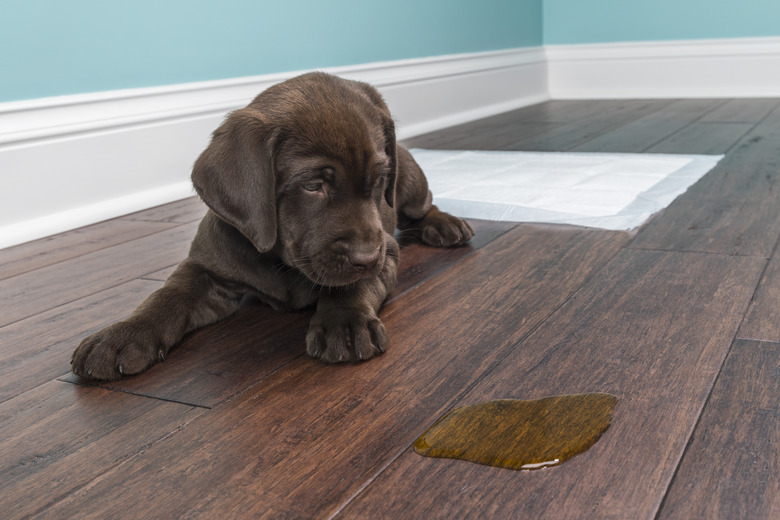How To Get Pet Stains Out Of Hardwood Floors
Pets and hardwood floors aren't always the best match. Between dog claw scratches and pet stains, your hardwood can take a beating. Acting fast to clean up poo, vomit and urine stains on hardwood floors is the key to getting rid of the stains and the smells. But sometimes you might need to do a little more to remove dark areas or odors that soak into the wood.
Damage Caused by Pets
If you have a young pet, accidents may be frequent until you make it through pet potty training. Older pets sometimes have accidents due to incontinence. But pets of any age can have an occasional accident or get sick and vomit on your hardwood floors. Whether you're dealing with poop, urine or vomit, you can usually avoid staining by cleaning it up right away. The finishes used on hardwood floors can hold off the pet mess for a short time.
But if you don't clean up dog pee on hardwood floors right away, it can soak down into the actual wood. This can happen if you don't notice the mess or if you have carpet over the hardwood and urine soaks through to the wood below. Urine is usually the worst as far as staining since it's a liquid, but poop or vomit can cause damage and staining, too. The ammonia in urine can be particularly powerful. If the urine soaks into the wood, it can cause dark staining. The smell also sticks with the wood. You may be able to get rid of the stains if they're fairly new and not very deep. But sometimes the pet mess can require sanding or even replacement of the wood.
Home Remedies for Urine Stains on Hardwood Floors
Pet stain removal products are available commercially, but you may also have success with items you have around the house. White vinegar, baking soda and hydrogen peroxide are common suggestions to clean up a urine stain on a wood floor.
White vinegar is known to have a disinfectant and deodorizing effect, which can help with your pet stains. Make your own hardwood floor cleaning solution by mixing a cup of white vinegar into a bucket of warm water. Adding grapefruit oil to the mix can help with the odor even more. Use this solution to scrub at the stains. Another option is to combine vinegar with baking soda to make a paste. Let the paste sit on the stain until it dries, then wipe it up. Baking soda also works well to soak up any liquids you use to remove the stains.
Soak a cloth in hydrogen peroxide. Place the cloth over the stain. You'll want to leave it there for at least eight hours or overnight to let it really go to work on the stain. The hydrogen peroxide helps to remove both the stain and the odor. You may need to leave the hydrogen peroxide on longer or repeat the process to get rid of more of the stain. It can discolor the section of floor, so prepare to do some sanding and refinishing work with this method.
Wood Bleach Products
Wood bleach is a specialty product designed to specifically lighten wood. You may have luck removing a lighter pet stain with wood bleach. It's usually the most effective when you first sand the affected area so the bleach can really penetrate the wood. Always follow the instructions for the specific wood bleach products you choose. Protect yourself by wearing gloves and keeping the area well ventilated while you work.
Sanding and Refinishing
Another option for getting rid of the stain is to sand the wood. If the stain isn't too deep, you may be able to sand down deep enough to get rid of it all. You'll need to stain the area where you sand to get it to match the surrounding area. You may need to do some blending with the stain to make the refinished area less noticeable. Even with sanding and refinishing, you may eventually notice the odor returning. This can happen when it reacts with chemicals in the finish. Or you might not notice it until the room gets warm and the odor becomes more noticeable.
Replacing Damaged Wood
If all else fails, you may need to replace the section of wood that's stained. If the pet stain is too deep, the wood may be permanently damaged. For a small stain, you might be able to cover it or live with it. But other stains go down too deep and can't be removed by any method. That sometimes happens when the mess seeps down into the joints between the boards or finds its way into cracks and goes deep into the wood.
If you want a uniform floor without large, noticeable stains or if the smell is an issue, the most effective solution is to get rid of the boards and put down new pieces. A flooring pro can help fit in new pieces of wood to make them look like they belong instead of looking like a quick patch job. In some cases, the urine may go all the way down to the subfloor or joists, which can require more extensive repairs.
Dealing with pet stains on your hardwood floors can be challenging. With the right tools, you can minimize the appearance and smell of the stains to return your floor to its former beauty.
